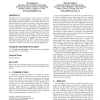Free Online Productivity Tools
i2Speak
i2Symbol
i2OCR
iTex2Img
iWeb2Print
iWeb2Shot
i2Type
iPdf2Split
iPdf2Merge
i2Bopomofo
i2Arabic
i2Style
i2Image
i2PDF
iLatex2Rtf
Sci2ools
ACMACE
2007
ACM
2007
ACM
Application of dimensionality reduction techniques to HRTFS for interactive virtual environments
Fundamental to the generation of 3D audio is the HRTF processing of acoustical signals. Unfortunately, given the high dimensionality of HRTFs, incorporating them into dynamic/interactive virtual environment and gaming applications is computationally very demanding. This greatly limits the performance of such applications that incorporate real-time 3D audio. This paper examines the application of data reduction models to HRTFs. In particular, the locally linear Isomap, Locally Linear Embedding (LLE), and the globally linear Principal Components Analysis (PCA) dimensionality reduction tools are applied to the MIT HRTF dataset. Our motivation is to project the inherently highdimensional space inherent in HRTF measurements onto a lower dimensionality such that they can be incorporated into interactive virtual environments and gaming applications. Categories and Subject Descriptors I.3.7 [Computer Graphics]: Three-Dimensional Graphics and Realism--Virtual reality General Terms Human Factor...
ACMACE 2007 | Dimensionality | Dimensionality Reduction | Human Computer Interaction | Principal Components Analysis |
| Added | 12 Aug 2010 |
| Updated | 12 Aug 2010 |
| Type | Conference |
| Year | 2007 |
| Where | ACMACE |
| Authors | Bill Kapralos, Nathan Mekuz |
Comments (0)

